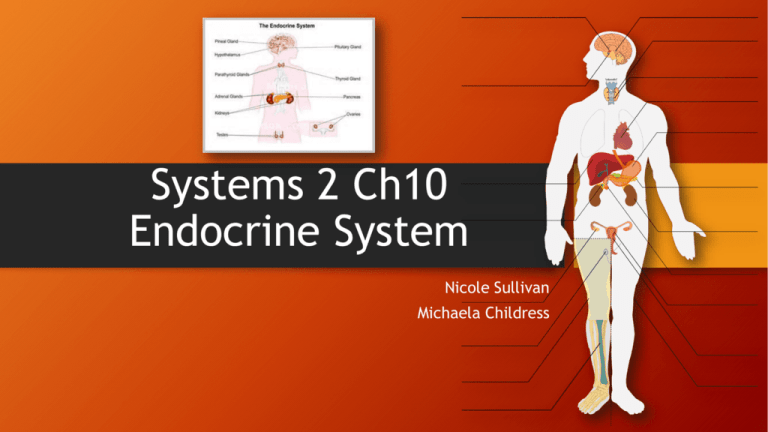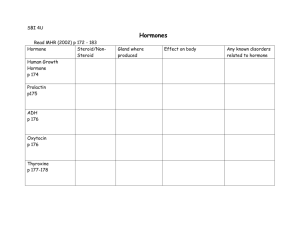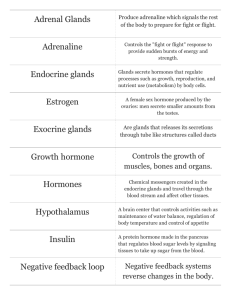System 2 Endocrine System 2 Endocrine
advertisement

Systems 2 Ch10 Endocrine System Nicole Sullivan Michaela Childress Definition - The Endocrine System The endocrine system refers to the collection of glands of an organism that secrete hormones directly into the circulatory system to be carried towards distant target organs. Vocab to Know to Understand Content • Hormones - a regulatory substance produced in an organism and transported in tissue fluids such as blood or sap to stimulate specific cells or tissues into action. • Secretion- a process by which substances are produced and discharged from a cell, gland, or organ for a particular function in the organism or for excretion. Hormones • Products of endocrine glands • Endocrine glands secrete hormones for a function • Proteins or steroids • Proteins- amino acids, inactivated by acid & pepsin in stomach injection (ex: insulin) • Steroids- lipid soluble, taken orally (sex hormones and those taken from adrenal cortex) Endocrine Gland Hormone Secretion The major endocrine glands are a system interrelationships & similar mechanisms of action, even though they’re all scattered around the body Mechanism of Hormone Action • Hormones are carried through blood, only affect certain cells • Cells that respond to a hormone have receptor sites • Receptor sites-lock & key mechanism • “If the key fits the lock, then the door will open” • if the hormone fits the receptor site there will be an effect • Located on the surface of the cell membrane or in the interior of the cell Target Tissue • All cells that have receptor sites for a hormone make up the target tissue for that hormone. • Target Tissue- Cells that have receptors for a given hormone • It’s either localized in a single gland or organ, or scattered throughout the body where more areas are affected • Cells in a target tissue have receptor sites for specific hormones. Insulin • Beta cells in pancreatic islets produce insulin • Works in response to high glucose levels in blood • Lowers blood glucose levels • Antagonistic to glucagon • Stimulates liver to remove glucose from blood and store it as glycogen Growth Hormone • Produced by the adenohypophysis • Protein that stimulates the growth of bones, muscles, & organs via protein synthesis • Influences height- too little or too much affects appearance • Acromegaly (acrom-egaly) • Ossification has taken place: Bone formation is complete, increase in bone length stops & bones increase in diameter (hands and face bones become abnormally large) Calcitonin • Secreted by the parafollicular cells of the thyroid gland • Hormone opposes the action of parathyroid glands by reducing calcium level in blood • Reduce rate at which calcium is released from bone Aldosterone • Mineralocorticoid are hormones secreted by the outermost region of the adrenal cortex • It is the Principal Mineralocorticoid • Effect is to conserve sodium and water • Primarily affects the kidneys • Also acts on intestines, salivary glands, and sweat glands Epinephrine • One of the two hormones secreted by the adrenal medulla • Epinephrine is also known as adrenaline • Makes up 80 percent of the medullary secretion • Made in response to stimulation of the sympathetic nerves (particularly in stressful situations) • Epinephrine and norepinephrine together cause increased heart rates Prostaglandins (prahs-tih-GLAN-dins) • Potent chemical regulators that are produced in minute amounts • Found widely distributed in cells throughout the body • Similar to hormones but there is enough difference to not be categorized as hormones • Has short-term, localized, immediate effect Pineal Gland • Also called pineal body or epiphysis cerebri • Small cone-shaped structure that extends posteriorly from the third ventricle of the brain • Source of melatonin • Active throughout the life of an individual • The presence of calcium in the gland suggests high metabolic activity Chapter Quiz Recall 1. 2. 3. 4. 5. 6. Product of an endocrine gland E) Hormone Cells that have receptors for a given hormone J) Target tissue Lipid-soluble hormones I) Steroid Produced by the adenohypophysis D) Growth hormone Produced by the thyroid gland B) Calcitonin Effect is to conserve sodium and water A) Aldosterone 7. Secreted by the adrenal medulla C) Epinephrine 8. Lowers blood glucose levels F) Insulin 9. Has short-term, localized, immediate effect H) Prostaglandin 10. Source of melatonin E) Pineal gland A. B. C. D. E. F. G. H. I. J. Aldosterone Calcitonin Epinephrine Growth hormone Hormone Insulin Pineal gland Prostaglandin Steroid Target tissue








